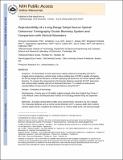| dc.contributor.author | Grulkowski, Ireneusz | |
| dc.contributor.author | Liu, Jonathan Jaoshin | |
| dc.contributor.author | Zhang, Jason Y. | |
| dc.contributor.author | Jayaraman, Vijaysekhar | |
| dc.contributor.author | Cable, Alex E. | |
| dc.contributor.author | Duker, Jay S. | |
| dc.contributor.author | Fujimoto, James G. | |
| dc.contributor.author | Potsaid, Benjamin M. | |
| dc.date.accessioned | 2015-12-13T03:25:43Z | |
| dc.date.available | 2015-12-13T03:25:43Z | |
| dc.date.issued | 2013-11 | |
| dc.identifier.issn | 01616420 | |
| dc.identifier.uri | http://hdl.handle.net/1721.1/100212 | |
| dc.description.abstract | Objective
To demonstrate a novel swept source optical coherence tomography (SS-OCT) imaging device using a vertical cavity surface-emitting laser (VCSEL) capable of imaging the full eye length and to introduce a method using this device for noncontact ocular biometry. To compare the measurements of intraocular distances using this SS-OCT instrument with commercially available optical and ultrasound biometers. To evaluate the intersession reproducibility of measurements of intraocular distances using SS-OCT.
Design
Evaluation of technology.
Participants
Twenty eyes of 10 healthy subjects imaged at the New England Eye Center at Tufts Medical Center and Massachusetts Institute of Technology between May and September 2012.
Methods
Averaged central depth profiles were extracted from volumetric SS-OCT datasets. The intraocular distances, such as central corneal thickness (CCT), aqueous depth (AD), anterior chamber depth (ACD), crystalline lens thickness (LT), vitreous depth (VD), and axial length (AL), were measured and compared with a partial coherence interferometry device (IOLMaster; Carl Zeiss Meditec, Inc., Dublin, CA) and an immersion ultrasound (IUS) A-scan biometer (Axis-II PR; Quantel Medical, Inc., Cournon d'Auvergne Cedex, France).
Main Outcome Measures
Reproducibility of the measurements of intraocular distances, correlation coefficients, and intraclass correlation coefficients.
Results
The standard deviations of the repeated measurements of intraocular distances using SS-OCT were 6 μm (CCT), 16 μm (ACD), 14 μm (AD), 13 μm (LT), 14 μm (VD), and 16 μm (AL). Strong correlations among all 3 biometric instruments were found for AL (r > 0.98). The AL measurement using SS-OCT correlates better with the IOLMaster (r=0.998) than with IUS (r=0.984). The SS-OCT and IOLMaster measured higher AL values than ultrasound (175 and 139 μm, respectively). No statistically significant difference in ACD between the optical (SS-OCT or IOLMaster) and ultrasound methods was detected. High intersession reproducibility of SS-OCT measurements of all intraocular distances was observed with intraclass correlation coefficients >0.99.
Conclusions
The SS-OCT using VCSEL technology enables full eye length imaging and high-precision, noncontact ocular biometry. The measurements with the prototype SS-OCT instrument correlate well with commercial biometers. The SS-OCT biometry has the potential to provide clinically useful comprehensive biometric parameters for pre- and postoperative eye evaluation. | en_US |
| dc.description.sponsorship | National Institutes of Health (U.S.) (Grant R01-EY011289-27) | en_US |
| dc.description.sponsorship | National Institutes of Health (U.S.) (Grant R01-EY013178-12) | en_US |
| dc.description.sponsorship | National Institutes of Health (U.S.) (Grant R01-EY013516-09) | en_US |
| dc.description.sponsorship | National Institutes of Health (U.S.) (Grant R01-EY019029-04) | en_US |
| dc.description.sponsorship | National Institutes of Health (U.S.) (Grant R44EY022864-01) | en_US |
| dc.description.sponsorship | National Institutes of Health (U.S.) (Grant R01-CA075289-16) | en_US |
| dc.description.sponsorship | National Institutes of Health (U.S.) (Grant R01-NS057476-05) | en_US |
| dc.description.sponsorship | National Institutes of Health (U.S.) (Grant R44CA101067-05) | en_US |
| dc.description.sponsorship | United States. Air Force Office of Scientific Research (Grant FA9550-10-1-0551) | en_US |
| dc.description.sponsorship | United States. Air Force Office of Scientific Research (Grant FA9550-10-1-0063) | en_US |
| dc.description.sponsorship | Thorlabs, Inc. | en_US |
| dc.language.iso | en_US | |
| dc.publisher | Elsevier | en_US |
| dc.relation.isversionof | http://dx.doi.org/10.1016/j.ophtha.2013.04.007 | en_US |
| dc.rights | Creative Commons Attribution | en_US |
| dc.rights.uri | http://creativecommons.org/licenses/by-nc-nd/4.0/ | en_US |
| dc.source | PMC | en_US |
| dc.title | Reproducibility of a Long-Range Swept-Source Optical Coherence Tomography Ocular Biometry System and Comparison with Clinical Biometers | en_US |
| dc.type | Article | en_US |
| dc.identifier.citation | Grulkowski, Ireneusz, Jonathan J. Liu, Jason Y. Zhang, Benjamin Potsaid, Vijaysekhar Jayaraman, Alex E. Cable, Jay S. Duker, and James G. Fujimoto. “Reproducibility of a Long-Range Swept-Source Optical Coherence Tomography Ocular Biometry System and Comparison with Clinical Biometers.” Ophthalmology 120, no. 11 (November 2013): 2184–2190. | en_US |
| dc.contributor.department | Massachusetts Institute of Technology. Department of Electrical Engineering and Computer Science | en_US |
| dc.contributor.department | Massachusetts Institute of Technology. Research Laboratory of Electronics | en_US |
| dc.contributor.mitauthor | Grulkowski, Ireneusz | en_US |
| dc.contributor.mitauthor | Liu, Jonathan Jaoshin | en_US |
| dc.contributor.mitauthor | Potsaid, Benjamin M. | en_US |
| dc.contributor.mitauthor | Fujimoto, James G. | en_US |
| dc.relation.journal | Ophthalmology | en_US |
| dc.eprint.version | Author's final manuscript | en_US |
| dc.type.uri | http://purl.org/eprint/type/JournalArticle | en_US |
| eprint.status | http://purl.org/eprint/status/PeerReviewed | en_US |
| dspace.orderedauthors | Grulkowski, Ireneusz; Liu, Jonathan J.; Zhang, Jason Y.; Potsaid, Benjamin; Jayaraman, Vijaysekhar; Cable, Alex E.; Duker, Jay S.; Fujimoto, James G. | en_US |
| dc.identifier.orcid | https://orcid.org/0000-0002-0828-4357 | |
| dspace.mitauthor.error | true | |
| mit.license | PUBLISHER_CC | en_US |
| mit.metadata.status | Complete | |
